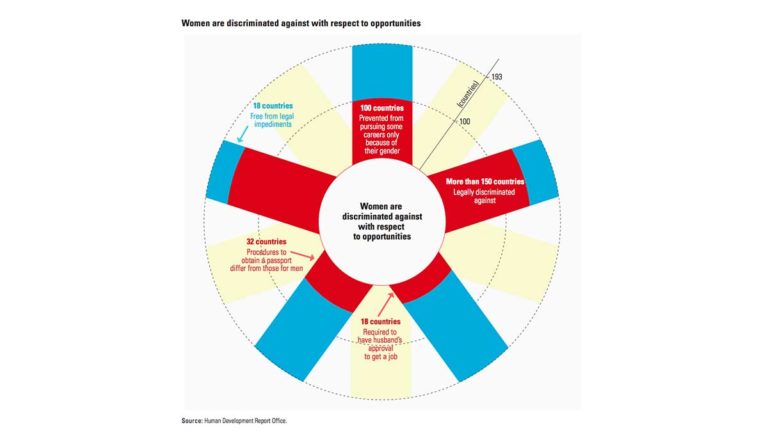Enabling (or Constraining) Progress for Women
Progress for women’s development is slow. An initiative funded by the Bill & Melinda Gates Foundation is working to more effectively address gender-based gaps.

Read Time: 3 minutes
Published:
It took 72 years for women in the United States to gain the right to vote after the suffrage movement began and 18 years after the Equal Pay Act was first introduced in Congress to be signed into law. In 2020, women will celebrate a century of voting rights in the United States. And still, many gains have yet to fully materialize – women still earn 79 cents to every dollar earned by a man, women of color make 55-60% of that of white men on average, and Louisiana’s gender wage gap, the worst in the U.S., is at 34.7%.
Needless to say, progress for women’s development is slow. And this pace of development varies around the world depending on where a woman lives. As the chart above shows, women are “prevented from pursuing some careers only because of their genders” in almost half the countries. Women are legally discriminated against in over 150 countries.
An initiative funded by the Bill & Melinda Gates Foundation is working to measure this progress to foster the ability to more effectively address these gender-based gaps. In 2016, Development Progress released a report, authored by Abigail Hunt and Emma Samman, examining women’s economic empowerment worldwide.
Hunt and Samman essentially define women’s economic empowerment as the process in which women and girls go from having limited to no power or economic freedom to having power and economic freedom. Empowering women and girls, as emphasized by the authors (and Sustainable Development Goal 5), is essential to global development as a whole. Evidence shows that prioritizing equal economic opportunity for women leads to greater investments in areas like health and education and can bolster national economies.
Such drastic societal changes are so challenging, however, because they require not only individual-level action but also profound shifts at the community, institution, market, and policy levels. To facilitate such a lofty endeavor, the authors identify 10 factors that constrain or enable women’s economic empowerment (pictured below). The inner wedges of the circle represent direct factors, which “target women individually and collectively.” The orange outer circle encompasses underlying environmental and structural factors.

Photo via Abigail Hunt and Emma Samman, Women’s Economic Empowerment: Navigating Enablers and Constraints. Overseas Development Institute.
“Achieving women’s economic empowerment,” the authors write, “requires an enabling environment in which women’s choices, power and agency are not limited by discriminatory or constraining institutions.” Discriminatory gender norms and legal frameworks, for instance, can constrain women’s choices, regardless of her individual efforts to seek out opportunities.
Therefore, interventions must address each factor holistically. From “[tackling] gender norms underpinning women’s disproportionate care load” to “[developing] long-term, flexible funding and programmes that recognise the non-linear nature of structural change,” the desired outcomes for economic empowerment seem gargantuan. But in the end, the authors argue, monitoring such progress and involving women in the efforts can propel them to a more equitable future.

Photo via Abigail Hunt and Emma Samman, Women’s Economic Empowerment: Navigating Enablers and Constraints. Overseas Development Institute.
Databyte via Human Development Report 2016. United Nations Development Programme (UNDP).



